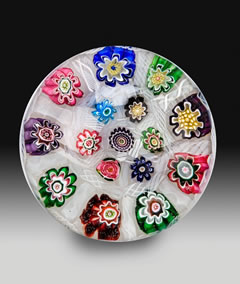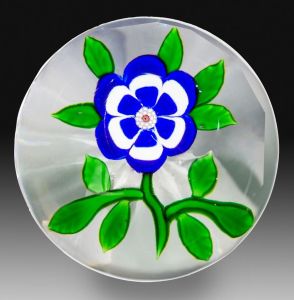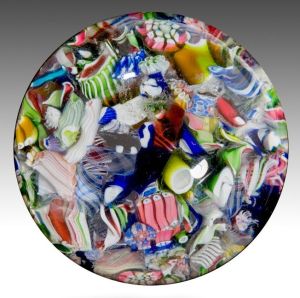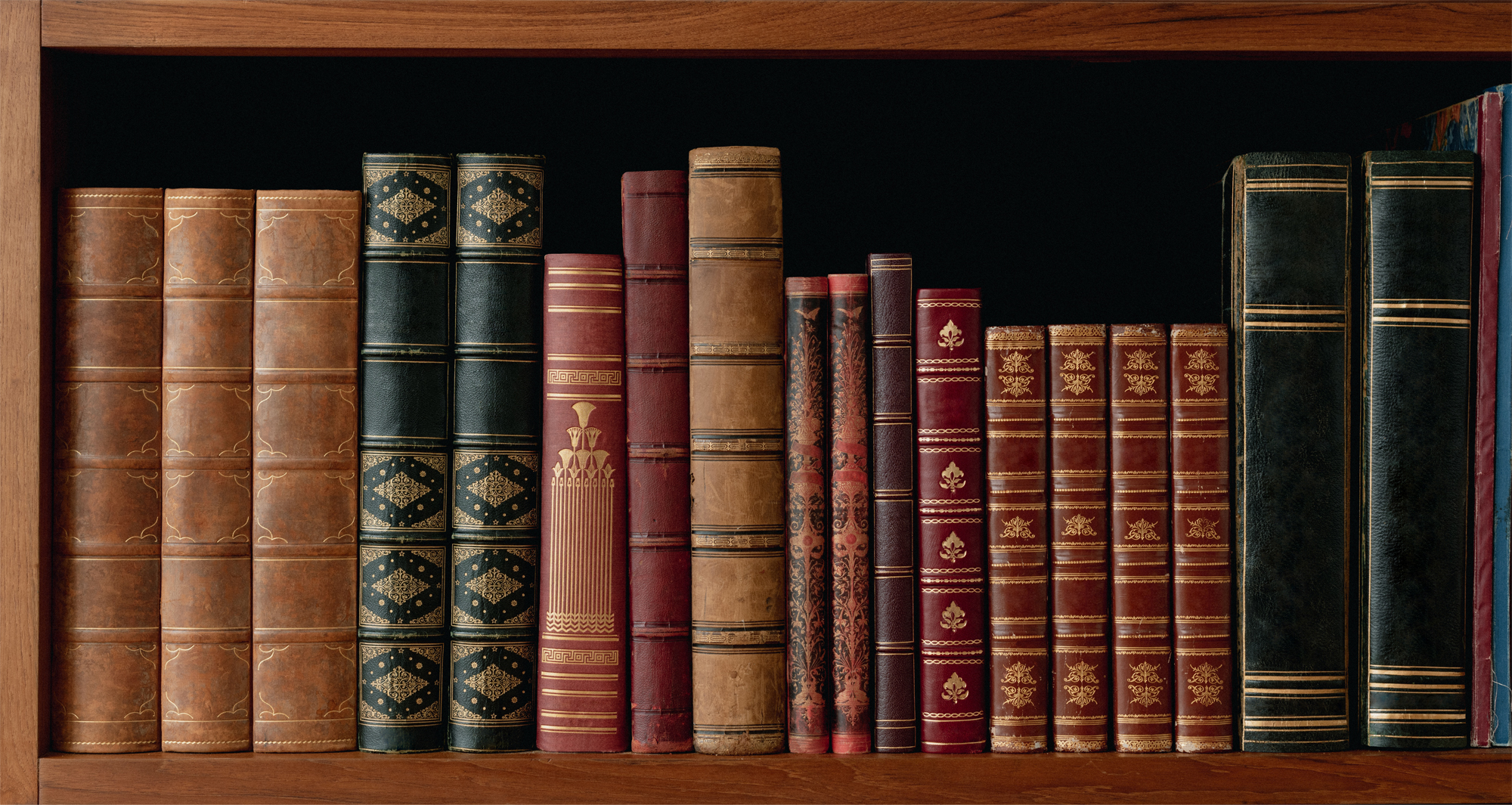Antique Glass Paperweights
A look at fine antique paperweights
 Most antique paperweights were made by one of three French factories, as a sideline, for just 10-15 years in the mid-1800s, and most collectors agree that only about 30,000-50,000 remain today. With many being tightly held by museums, only a precious few remain on the market.
Most antique paperweights were made by one of three French factories, as a sideline, for just 10-15 years in the mid-1800s, and most collectors agree that only about 30,000-50,000 remain today. With many being tightly held by museums, only a precious few remain on the market.
Paperweights are surprisingly precise wonders to behold. When you hold a fine paperweight in your hand, feel its silky smoothness and cool weight, and then gaze into the clear glass-magnifying dome, there is an undefined but undeniable magic. You are absorbed into it, mesmerized by its precision and beauty.
The respected author, historian and collector of fine art, Paul Hollister, said about paperweights, “They cry out for a recognized place in the hierarchy of beautiful objects made by man. The finest of them, created by true and great artists, rank with the finest illuminated manuscripts, the bronzes of Cellini, the boxes of Fabergè, or the portraits of the greatest of the miniaturists.”
The former director of the Corning Museum of Glass, Dwight Lanmon said, “They are the crown jewels for collectors.” Lanmon also said, “Paperweights represent the culmination of 3,500 years of glassmaking artistry and experimentation.”[clear]
Paperweight definition and types
The paperweight format is usually solid glass, circular (about 3 inches in diameter) with a flat base, and an interior design encased in a hemispheric dome of clear crystal to provide weight, protect, preserve and magnify the fragile internal design.
There are three basic types of paperweights. The first type, termed “sulphides,” features molded ceramic plaques, usually with the profile in bas-relief, of a person to be commemorated. These were followed by the millefiori (Italian, meaning thousand flowers) designs of colorful glass canes in geometric patterns. The millefiori technique had been around for almost 2,000 years, but had been used previously only to decorate glass plates, vessels and jewelry
The lampwork weights include sculpted lifelike single flowers and bouquets, or animals made of glass. Many of these look so lifelike that they are often thought to be real. These became very popular because of the Victorian “language of flowers” in which flowers were used to convey covert messages. In this way, a paperweight with a simple flower could be given to a friend that carried a message of friendship, but a different flower could be given to a lover carrying a message of love.
History: When, where and why were they made
 Glass paperweights were first made in 1845 by Venetian glassmakers to be shown at a trade fair in Vienna. The French representatives saw these pretty objects and their glassmakers proceeded to capture the market with their more precise work.
Glass paperweights were first made in 1845 by Venetian glassmakers to be shown at a trade fair in Vienna. The French representatives saw these pretty objects and their glassmakers proceeded to capture the market with their more precise work.
The French factories of Baccarat, Clichy and Saint Louis made the finest paperweights. Letter writing became a fad at the time, and paperweights were sold as an attractive accessory to desk sets of pens, inkwells and blotters and stationery. Fads come and fads go, however, and the demand for paperweights was satisfied by 1855-1860, and their production sharply fell off as French glass factories went on to make higher profit items.
American paperweights were manufactured from 1851, into the 1880s, by the Boston and Sandwich Glass Company, and the New England Glass Company – and more rarely by Dorflinger, Mount Washington, and Gillinder. The glassmakers were mainly European immigrants already skilled in the techniques, which explains why American weights are somewhat imitative of the European. American glassworkers were not as constrained or regimented, so their weights sometimes lack the quality and precision of the French. What American weights may have lacked in quality, they more than made up for in creativity and ingenuity. This makes them even more charming and desirable to collectors.
Paperweights were also made by Bohemian glassworks (most unnamed) and more rarely by the Belgians (Val St. Lambert, Saint Mande), the English (Bacchus), and even a very few by the Russians.
The mid-to-late 1800s were a sentimental and romantic time, heralded by an emerging middle class. Paperweights were frequently given as gifts to friends and loved ones.
Paperweight collecting
Collecting paperweights began shortly after their production ceased, primarily by aristocracy and royalty. The first included Queen Mary, Queen Victoria, Napoleon III’s Empress Eugénie, and others. It is impressive that these very privileged individuals chose to collect paperweights, which were relatively inexpensive at the time. They must have recognized the beauty and sentimentality of these well- designed and well-crafted items.
Collecting paperweights became more common in the early 20th century, when some outstanding collections were formed.
They were recognized as a legitimate form of the decorative arts in 1925, when Sotheby’s conducted the first major auction of paperweights. The number of collectors increased markedly after 1953, when the Paperweight Collectors Association was formed. Today there are an estimated 20,000 paperweight collectors, but not all collect antiques.
Three famous collectors, whose paperweights are now in museums, include: Amory Houghton, who built an outstanding collection over an approximately 50-year span, beginning in the early 1930s. Houghton was chairman emeritus of Corning Glass Works. He spent his life in the glass industry, yet with an exposure to the many different forms of glass art, he chose to collect paperweights. The Houghton Collection of 288 weights forms the nucleus of the paperweight collection at the prestigious Corning Museum of Glass.
Evangeline Bergstrom, the wife of a wealthy paper manufacturer, collected about 700 weights from 1935 to 1944. Her collection formed the nucleus of the Bergstrom-Mahler Museum, in Neenah, Wis., which opened in 1959. Its collection has now grown to more than 2,200 paperweights through donations, bequeaths, and acquisitions. It is the largest paperweight museum in the world.
Arthur Rubloff, the developer of the Miracle Mile in Chicago, was introduced to paperweights in the early 1950s and proceeded to build the world’s greatest collection. In 1978, he donated 1,472 weights from his collection to the Art Institute of Chicago, where they remain today.
These exceptional collectors through the years usually had two things in common: first, a true passion for collecting, and second, the privilege of having sufficient financial resources to build extensive collections. A privileged life is not necessary to enjoy a collection, however.
A collector with modest means may enjoy their collection as much as a wealthy person does. The only differences are usually the rarity and the number of weights in the collections.
What to expect to pay and judging value
 You might be wondering about the value of these rare and fascinating objects; it’s a complex issue. The primary factors influencing the value of antique paperweights are the maker (French are generally the most valuable), rarity of the design (the more rare the design, the more valuable), symmetry and centering of the design (the more symmetrical, the more valuable), internal flaws such as bubbles, tilted canes, or cracks (fewer flaws are more valuable), size (most vary from about 2½ inches to 3¼ inches diameter – the larger the better. An exception is the miniatures, which are under 2 inches diameter.), present condition of the exterior (the less restoration and scratches/chips the better), and overall visual impact.
You might be wondering about the value of these rare and fascinating objects; it’s a complex issue. The primary factors influencing the value of antique paperweights are the maker (French are generally the most valuable), rarity of the design (the more rare the design, the more valuable), symmetry and centering of the design (the more symmetrical, the more valuable), internal flaws such as bubbles, tilted canes, or cracks (fewer flaws are more valuable), size (most vary from about 2½ inches to 3¼ inches diameter – the larger the better. An exception is the miniatures, which are under 2 inches diameter.), present condition of the exterior (the less restoration and scratches/chips the better), and overall visual impact.
Provenance is only an issue if it is from one of the few historic collections.
Value is always a trade-off of all these eight factors. They are important to collectors, who, as individuals, may value one factor above others.
Because paperweights were all handmade, there are usually variations and flaws in each of them, each of which affects the value. The more perfect the design and the fewer the flaws, the higher the price.
This article was reproduced by kind permission of www.antiquetrader.com


